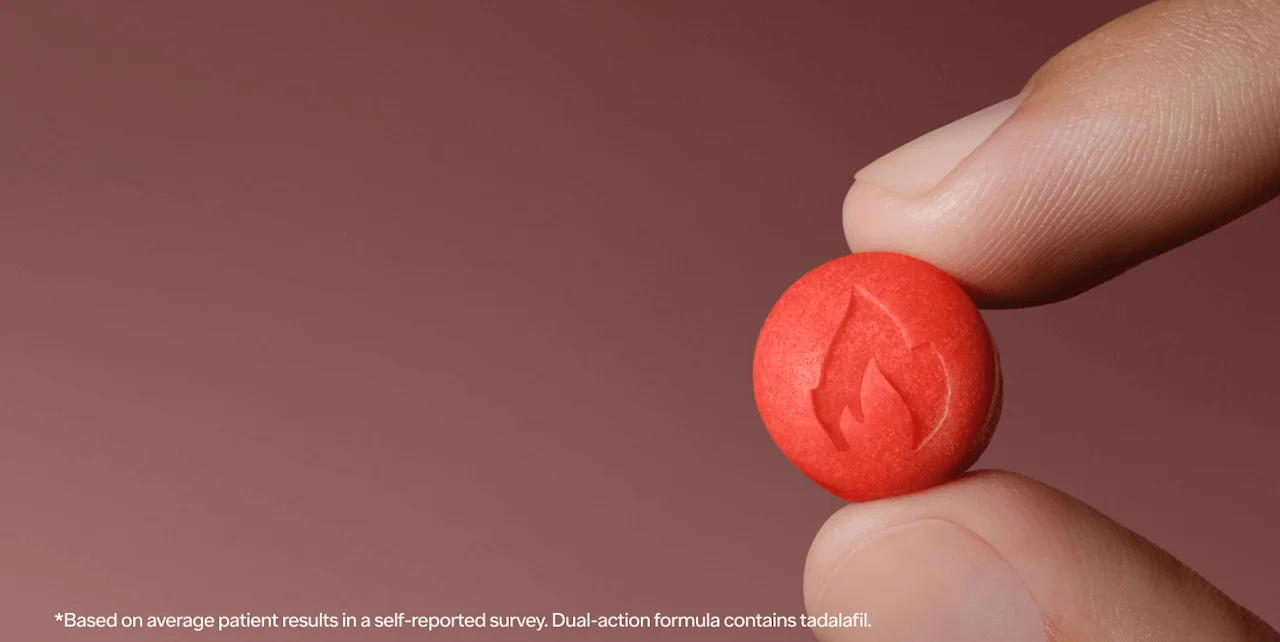Here's what we'll cover
If you struggle with erectile dysfunction (ED), you may have been prescribed that famous little blue pill, Viagra, also known by its generic name, sildenafil. While sildenafil is very effective at helping men get and maintain strong erections and most men tolerate it well, some people may experience unpleasant side effects. If you’re wondering how to reduce side effects of sildenafil, keep reading for some helpful tips and alternative treatments to consider.
What does Viagra do?
Viagra (sildenafil) is a brand-name prescription drug used to treat erectile dysfunction. It’s part of a drug class called PDE-5 inhibitors, which work by increasing blood flow to the penis during sexual activity, a necessary component of a strong erection.
After taking Viagra, the medication usually starts to work within an hour—but you can take it anywhere from 30 minutes to 4 hours before sexual activity.
The effects of Viagra can last from 4 to 8 hours, depending on each person, as well as the amount you take. It’s important to note that Viagra won’t cause an erection without sexual stimulation (Smith, 2022).
If your erection lasts longer than 4 hours—even if it’s not painful—seek medical attention as soon as possible. An erection lasting longer than 4 hours is known as priapism, which can cause permanent damage to the penis if left untreated (Halls, 2012).
Most common side effects of sildenafil
Most people tolerate Viagra well, but like any medication, it has the potential to cause some side effects.
Common side effects of Viagra include (Smith, 2022):
Headache
Flushing
Indigestion
Nasal congestion (stuffy nose)
Back pain
Muscle pain
Nausea
Dizziness
Rash
Less commonly, some people experience mild and temporary vision changes, such as blue-tinged vision, blurred vision, and sensitivity to light.
Most of the above side effects tend to go away within a few days or a couple of weeks. However, if these side effects become more severe or do not go away over time, talk to your healthcare provider.
Serious side effects of Viagra (sildenafil)
Rarely, serious side effects of Viagra do happen. If you experience any of the following, call your healthcare provider right away. If your symptoms feel life threatening or you think you’re having a medical emergency, call 911.
Serious side effects of Viagra can include:
NAION, or non-arteritic anterior ischemic optic neuropathy: NAION is an eye condition that causes damage to your optic nerve that can cause a sudden loss of vision in one or both of your eyes. Viagra may increase the risk of vision loss in people with retinitis pigmentosa, an inherited disease of the retina (Nivison-Smith, 2014).
Sudden decrease or loss of hearing: This condition may also involve other symptoms, such as tinnitus or dizziness.
Priapism: Priapism is a long-lasting and sometimes painful erection and is a medical emergency that needs to be treated immediately. Without treatment, this prolonged erection can cause permanent damage to the penis and irreversible erectile dysfunction.
Low blood pressure: This is generally only an issue if Viagra is taken with certain other medications that also increase the risk of low blood pressure.
How to get rid of Viagra (sildenafil) side effects
If you are experiencing bothersome side effects from taking Viagra, talk to your healthcare provider. They may recommend taking a lower dose of the medication or may suggest another type of treatment for your condition.
For minor side effects including flushing, indigestion, dizziness, or back and muscle pain, there are a few tips that may help you manage these symptoms.
Flushing: If you experience a hot flush, try to cool down by opening a window, turning on a fan, or having a cold drink. It may also help to lie down for a bit and rest. If you are prone to hot flashes while taking Viagra, drinking alcohol can make this worse.
Indigestion: If you notice that Viagra upsets your stomach, try taking it with food—though this may mean it takes longer for the drug to work. While antacids can also help with indigestion, you can always ask your pharmacist for a more specific suggestion.
Dizziness: If you are prone to dizzy spells after taking Viagra, you may need to lie down and rest for a few minutes after taking the medication. Try to get up slowly as the dizziness passes. While drinking plenty of fluids can help, drinking alcohol and smoking may make your dizziness worse.
Back or muscle pain: It can help to lie down or do gentle self-massage. Ask your pharmacist about over-the-counter pain relievers that can help as well.
In rare cases, some more serious side effects can cause long-term complications. These include:
Vision-related side effects: Viagra can sometimes cause temporary changes to your vision after taking a dose. The most common of these is a blue tinge to your vision, though side effects include blurred vision or sensitivity to light. While these side effects are usually mild and go away quickly, in rare cases it’s possible to experience permanent vision loss. It may help to turn off or dim any bright lights after taking the medication. However, if you experience vision loss in one or both eyes, call your provider right away.
Low blood pressure: Viagra can lower your blood pressure after taking a dose. For most people, this is temporary and does not cause serious problems. If you want to avoid low blood pressure while taking Viagra, it may help to drink plenty of nonalcoholic fluids in the hour before you take a dose.
Other treatments for ED
If, for some reason, you can’t get relief from Viagra’s side effects, rest assured there are several other treatments available for erectile dysfunction.
PDE-5 inhibitors
Viagra is just one of several PDE-5 inhibitors available to treat ED. Other options include:
Vardenafil (Levitra)
Avanafil (Stendra)
All of these oral medications work the same way as Viagra, by increasing blood flow to the penis and allowing for an erection in response to sexual stimulation. However, each of these medications varies in dosage, how long they work, and their side effects.
Other medications
While PDE-5 inhibitors are the most common treatment for ED, other treatments are available. Other medications used to treat ED include:
Alprostadil self-injection: Alprostadil is an injectable medication, usually injected into the base or side of the penis. Each penis injection is dosed to create an erection lasting no longer than an hour, and because the needle used is very fine, pain from the injection site is usually minor (DailyMed, 2022).
Alprostadil urethral suppository: Alprostadil intraurethral therapy involves placing a tiny alprostadil suppository inside your penis through the urethra. The erection usually starts within 5–10 minutes and, when effective, lasts between 30 and 60 minutes (DailyMed, 2018).
Testosterone replacement therapy: In some men, ED may be caused by low levels of the hormone testosterone. In this case, testosterone replacement therapy (TRT) might be recommended.
Pumps and implants
If medications aren’t effective or appropriate for your ED, your healthcare provider may recommend one of the following treatments:
Penis pumps: A penis pump (aka vacuum erection device) is a hollow tube with a hand-powered or battery-powered pump. When the tube is placed over your penis, it is used to suck out the air inside the tube, creating a vacuum that pulls blood into the penis. Once you get an erection, you slip a tension ring around the base of your penis to hold in the blood and keep it firm. You then remove the vacuum device.
Penile implants: A penile implant is a surgical solution where a device is placed into both sides of the penis. These implants consist of either inflatable or malleable (bendable) rods. Inflatable devices allow you to control when and how long you have an erection.
No matter what the cause of your erectile dysfunction is, it can be a distressing source of emotional and psychological stress—for both you and your partner. If you experience ED and can’t tolerate the side effects of Viagra, don’t lose hope. There are many available treatments to help you have a healthy and vibrant sex life.
DISCLAIMER
If you have any medical questions or concerns, please talk to your healthcare provider. The articles on Health Guide are underpinned by peer-reviewed research and information drawn from medical societies and governmental agencies. However, they are not a substitute for professional medical advice, diagnosis, or treatment.
Viagra Important Safety Information: Read more about serious warnings and safety info.
Cialis Important Safety Information: Read more about serious warnings and safety info.
References
Andersson, K. E. (2018). PDE5 inhibitors - pharmacology and clinical applications 20 years after sildenafil discovery. British Journal of Pharmacology, 175 (13), 2554–2565. doi:10.1111/bph.14205. Retrieved from https://bpspubs.onlinelibrary.wiley.com/doi/10.1111/bph.14205
DailyMed. (2022). Edex, alprostadil injection. Retrieved from https://dailymed.nlm.nih.gov/dailymed/drugInfo.cfm?setid=e8b8ec8d-1318-43e4-a182-446e9f9579de
DailyMed. (2018). Muse, alprostadil suppository. Retrieved from https://dailymed.nlm.nih.gov/dailymed/drugInfo.cfm?setid=4c55f3f9-c4cf-11df-851a-0800200c9a66
Halls, J. E., Patel, D. V., Walkden, M., et al. (2012). Priapism: pathophysiology and the role of the radiologist. The British Journal of Radiology, 85 Spec No 1 (Spec Iss 1), S79–S85. doi:10.1259/bjr/62360925. Retrieved from https://pmc.ncbi.nlm.nih.gov/articles/PMC3746404/
McMurray, J. G., Feldman, R. A., Auerbach, S. M., et al. (2007). Long-term safety and effectiveness of sildenafil citrate in men with erectile dysfunction. Therapeutics and Clinical Risk Management, 3 (6), 975–981. Retrieved from https://www.ncbi.nlm.nih.gov/pmc/articles/PMC2387281/
National Institute of Diabetes and Digestive and Kidney Diseases. (2022). Definition & facts for erectile dysfunction . Retrieved from https://www.niddk.nih.gov/health-information/urologic-diseases/erectile-dysfunction/definition-facts
Nivison-Smith, L., Zhu, Y., Whatham, A., et al. (2014). Sildenafil alters retinal function in mouse carriers of retinitis pigmentosa. Experimental Eye Research, 128, 43–56. doi:10.1016/j.exer.2014.08.014. Retrieved from https://www.sciencedirect.com/science/article/abs/pii/S0014483514002383?via%3Dihub
Smith, B. P. & Babos, M. (2022). Sildenafil. StatPearls . Retrieved on Dec. 7, 2022 from https://www.ncbi.nlm.nih.gov/books/NBK558978/













